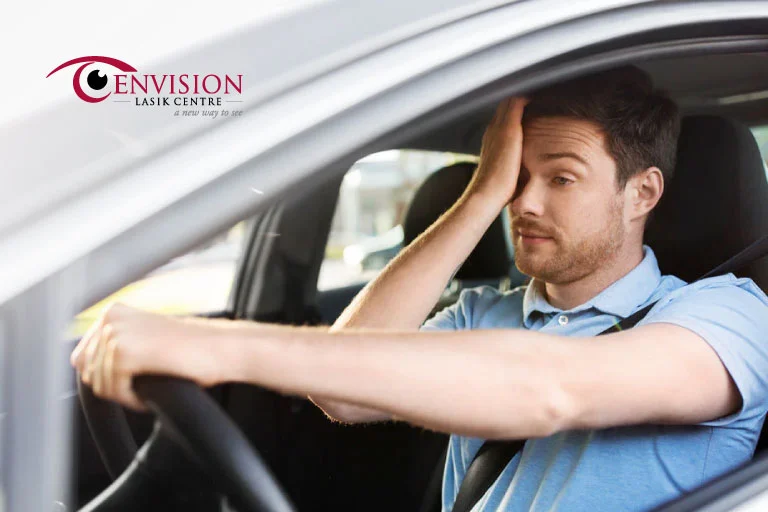Can I Drive with Keratoconus? Everything You Need to Know

AUTHOR
Ophthalmologist/ Eye Surgeon 13+ Years Exp
MBBS, MS – Ophthalmology
TSMC- TSMC/FMR/05251 (2018)
CONDITION
CALL US 24/7 FOR ANY HELP
GET IN TOUCH ON
If you’ve been diagnosed with keratoconus, one question might be nagging at you every time you grab your car keys—“Can I still drive safely?” It’s a valid concern. Driving depends on good vision, and since keratoconus impacts your eyesight, it’s natural to wonder if it could affect your ability to drive—even legally.
Don’t worry—we’re here to give you the answers you’re looking for. This blog will explore how keratoconus interacts with driving, discuss safety considerations, and provide helpful tips to manage your vision, so you feel confident behind the wheel.
How Does Keratoconus Impact Driving?
Keratoconus affects your cornea, causing it to bulge into a cone shape and distort your vision. This distortion can make it difficult to focus clearly on the road. Some of the most common visual challenges for drivers with keratoconus include:
- Blurry vision: Road signs can look smeared or hard to read.
- Light sensitivity: Oncoming headlights and streetlights might feel painfully bright.
- Halos and glare: You could notice rings or rays radiating from lights, making night driving especially tricky.
- Double vision: Objects may appear shadowy or duplicated, particularly in one eye.
- Depth perception issues: Judging distances might not feel as natural as it used to, which can complicate tasks like parking or overtaking.
These symptoms vary in severity depending on how advanced your keratoconus is and how well it’s being managed.
Can You Legally Drive with Keratoconus?
The ability to drive legally boils down to one key factor: vision clarity. For most jurisdictions, you need to meet a certain standard of visual acuity (20/40 with corrective lenses in most places) to hold a driver’s license.
If your keratoconus is mild or well-corrected with glasses or contact lenses, you’re likely fine to drive legally. However, if your vision deteriorates and corrective measures no longer help you meet these standards, you might need to consider alternatives like public transportation or rideshare until it’s addressed.
If you’re in doubt, talk to your eye care provider. They can test your visual acuity and help you determine if you meet the driving requirements in your area.
Is Driving with Keratoconus Safe?
Here’s the big question—not only “can I drive,” but “should I drive?” Safety is the most important consideration. Even if you’re legally allowed to drive, it’s crucial to ask yourself if you feel confident and aware of your surroundings while on the road.
Driving is a skill that depends heavily on clear and rapid visual input. Challenges like glare from headlights or trouble recognizing signs could make driving with keratoconus riskier, especially when conditions aren’t ideal (think night driving, fog, or heavy rain).
How to Make Driving Safer with Keratoconus?
Good news—even with keratoconus, there are tools and strategies to help you drive more confidently. Here are some actionable tips to consider:
1. Invest in Proper Vision Correction
This is your first and most crucial step. Depending on how advanced your keratoconus is, you may need special types of contact lenses like:
- Rigid Gas Permeable (RGP) lenses: These create a smooth surface over your cornea, offering sharper vision.
- Scleral lenses: These rest on the white part of your eyes and vault over the cornea, providing excellent comfort and clarity.
- Hybrid lenses: A combination of soft and hard lenses for better comfort and focus.
Regular glasses might work in early stages, but as keratoconus progresses, these specialized lenses offer better correction for driving safety.
2. Use Polarized or Anti-Glare Glasses
Bright sunlight or oncoming headlights can be particularly harsh if you have keratoconus. Polarized sunglasses can cut glare during the day, while anti-reflective coatings on your lenses can reduce glare from headlights at night.
3. Adjust Your Driving Habits
Consider when and where you drive. If night driving feels difficult because of glare or low light, limit your trips after dark. Similarly, avoid driving in heavy rain or fog where visibility is naturally reduced for everyone.
4. Keep Your Windshield Spotless
This might sound simple, but a clean windshield can make a big difference. Dirt and smudges can amplify glare, which is the last thing you need when keratoconus is already causing visual distortions.
5. Practice Defensive Driving
If your vision makes certain situations more challenging, being prepared and cautious will help enhance your safety. Maintain extra space between your car and others, avoid speeding, and anticipate what’s happening around you on the road.
6. Stay on Top of Eye Checkups
Regular visits to your eye specialist aren’t just a good idea—they’re essential. Your optometrist or ophthalmologist can monitor the progression of your keratoconus and ensure your vision correction is always up to par for driving.
If treatment options like corneal cross-linking are recommended, they can help stabilize your condition and protect your eyesight long-term.
When to Stop Driving ?
It’s never easy to step away from driving, but sometimes, safety has to come first. If you’re consistently struggling to see road signs, judge distances, or feel overwhelmed by glare and light sensitivity—even after trying corrective measures and treatments—it might be time to explore other transportation options.
Remember, stopping driving doesn’t mean the end of independence. With rideshare apps and great public transit options now available, there are plenty of ways to stay mobile and connected.
Take Control of Your Vision Today
Driving with keratoconus doesn’t necessarily mean you have to hand over your keys. With proper care, the right vision correction, and a few adjustments, you can retain your confidence on the road.
But here’s the important part: don’t put this off. Early diagnosis and treatment are critical to preserving your vision and making activities like driving as safe and stress-free as possible.
If you’re dealing with keratoconus and wondering about your driving or vision options, schedule an eye exam with a specialist. They’ll provide expert advice tailored to your condition and lifestyle, including recommendations for lenses, treatments, and more.
Your vision matters. Take control today and drive into a future of clarity and confidence!
Get expert care at Envision Lasik Centre, Hyderabad – the top hospital for keratoconus treatment.
Book your consult today!
AUTHOR
Ophthalmologist/ Eye Surgeon 13+ Years Exp
MBBS, MS – Ophthalmology
TSMC- TSMC/FMR/05251 (2018)
CONDITION
CALL US 24/7 FOR ANY HELP
GET IN TOUCH ON



